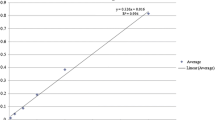Abstract
Nepafenac, the amide analog of 2-amino-3-benzoylbenzeneacetic acid (amfenac), was examined in preclinical models for its potential utility as a topical ocular anti-inflammatory agent. Diclofenac was selected as the reference compound. In contrast to diclofenac (IC50 = 0.12 μM), nepafenac exhibited only weak COX-1 inhibitory activity (IC50 = 64.3 μM). However, amfenac was a potent inhibitor of both COX-1 (IC50 = 0.25 μM) and COX-2 activity (IC50 = 0.15 μM). Ex vivo, a single topical ocular dose of nepafenac (0.1%) inhibited prostaglandin synthesis in the iris/ciliary body (85–95%) and the retina/choroid (55%). These levels of inhibition were sustained for 6 h in the iris/ciliary body and 4 h in the retina/choroid. Diclofenac (0.1%) suppressed iris/ciliary body prostaglandin synthesis (100%) for only 20 min, with 75% recovery observed within 6 h following topical dosing. Diclofenac's inhibition of prostaglandin synthesis in the retina/choroid was minimal. Nepafenac's inhibitory efficacy and longer duration of action was confirmed in a trauma-induced rabbit model of acute ocular inflammation monitoring protein or PGE2 accumulation in aqueous humor. Results warrant further assessment of nepafenac's topical ocular efficacy in the treatment of postoperative ocular pain, inflammation, and posterior segment edema.
Similar content being viewed by others
REFERENCES
SANCILIO, L. F., D. L. REESE, C. CHEUNG, and R. S. ALPHIN. 1977. AHR-5850: a potent anti-inflammatory compound. Agents Actions, 7:133-144.
WALSH, D. A., H. W. MORAN, D. A. SHAMBLEE, I. M. UWAYDAH, W. J. WELSTEAD, JR., L. F. SANCILIO, and W. N. DANNENBURG. 1984. Anti-inflammatory agents. 3. Synthesis and pharmacological evaluation of 2-amino-3-benzoylphenylacetic acid and analogues. J. Med. Chem., 27:1379-1388.
WALSH, D. A., H. W. MORAN, D. A. SHAMBLEE, W. J. WELSTEAD, JR., J. C. NOLAN, L. F. SANCILIO, and G. GRAFF. 1990. Anti-inflammatory agents. 4. Syntheses and biological evaluation of potential prodrugs of 2-amino-3-benzoylbenzeneacetic acid and 2-amino-3-(4-chlorobenzoyl) benzeneacetic acid. J. Med. Chem., 33:2296-2304.
JAIN, A. K., C. C. HUNLEY, J. KUEBEL, F. G. MCMAHON, and J. J. RYAN. 1986. Analgesic efficacy of amfenac, aspirin and placebo after extraction of impacted teeth. Pharmacotherapy, 6:236-240.
HIRANUMA, T., S. KATO, and M. HACHISU. 1988. Analgesic action of amfenac Na, a nonsteroidal anti-inflammatory agent. J. Pharmacobiodyn., 11:612-619.
NICHOLS, J., and R. W. SNYDER. 1998. Topical nonsteroidal anti-inflammatory agents in ophthalmology. Curr. Opin. Ophthalmol., 9:40-44.
COOK, H. W., G. FORD, and W. E. M. LANDS. 1979. Instrumental improvements for rapid, detailed kinetic studies of oxygenase activity. Anal. Biochem., 96:341-351.
GRAFF., G., and L. A. ANDERSON. 1989. 1-[4-[3-[4-[Bis(4-fluorophenyl)hydroxymethyl]-1-piperidinyl]propoxy]-3-methoxyphenyl]ethanone (AHR-5333): A selective human blood neutrophil 5-lipoxygenase inhibitor. Prostaglandins, 38:473-496.
GRAFF, G., M. T. BRADY, D. A. GAMACHE, J. M. SPELLMAN, and J. M. YANNI. 1998. Transient loss of prostaglandin synthetic capacity in the rabbit iris-ciliary body following anterior chamber paracentesis. Ocular Immunol. Inflamm., 6:227-238.
POWELL, W. S. 1985. Reversed-phase high-pressure liquid chromatography of arachidonic acid metabolites formed by cyclooxygenase and lipoxygenase. Anal. Biochem., 148:59-69.
BRADFORD, M. M. 1976. A rapid and sensitive method for the quantitation of microgram quantities of protein utilizing the principle of protein-dye binding. Anal. Biochem., 72:248-254.
ROME, L. H., and W. E. M. LANDS. 1975. Structural requirements for time-dependent inhibition of prostaglandin biosynthesis by anti-inflammatory drugs. Proc. Natl. Acad. Sci. U.S.A., 72:4863-4865.
KE, T.-L., G. GRAFF, J. M. SPELLMAN, and J. M. YANNI. Nepafenac, a unique nonsteroidal prodrug with potential utility in the treatment of trauma-induced acute ocular inflammation. II. In vitro bioactivation and permeation of external ocular barriers. (In press.)
KULKARNI, P. S., and B. D. SRINIVASAN. Cyclooxygenase and lipoxygenase pathways in anterior uvea and conjunctiva. 1989. In: The Ocular Effects of Prostaglandins and Other Eicosanoids, Editors; Bito L. Z., J. Sternschantz. Alan R. Liss, Inc., New York, 39-52.
SALL, K. N., and T. A. PASQUINE. The Nepafenac Dose-Response Study Group. 1998. Nepafenac is effective in reducing anterior chamber inflammation following cataract surgery. Invest. Ophthalmol. Vis. Sci., 39(suppl):851.
JAMPOL, L. M., S. JAIN, B. PUDZISZ, and R. N. WEINREB. 1994. Nonsteroidal anti-inflammatory drugs and cataract surgery. Arch. Ophthalmol., 112:891-894.
ABELSON, M. B., and L. PARVER. 1994. How to handle CME in pseudophakes. Rev. Ophthalmol., 1:138-139.
GINSBURG, A. P., J. K. CHEETHAM, R. E. DEGRYSE, and M. ABELSON. 1995. Effects of flurbiprofen and indomethacin on acute cystoid macular edema after cataract surgery: Functional vision and contrast sensitivity. J. Cataract Refract. Surg., 21:82-92.
PETERSON, M., M. O. YOSHIZUMI, R. HELPLER, B. MONDINO, and A. KREIGER. 1992. Topical indomethacin in the treatment of chronic cystoid macular edema. Graefe's Arch. Clin. Exp. Ophthalmol., 230:401-405.
JOHNSON, E. I. M., M. E. DUNLOP, and R. G. LARKINS. 1999. Increased vasodilatory prostaglandin production in the diabetic rat retinal vasculature. Curr. Eye Res., 18:79-82.
Author information
Authors and Affiliations
Rights and permissions
About this article
Cite this article
Gamache, D.A., Graff, G., Brady, M.T. et al. Nepafenac, a Unique Nonsteroidal Prodrug with Potential Utility in the Treatment of Trauma-Induced Ocular Inflammation: I. Assessment of Anti-Inflammatory Efficacy. Inflammation 24, 357–370 (2000). https://doi.org/10.1023/A:1007049015148
Issue Date:
DOI: https://doi.org/10.1023/A:1007049015148




